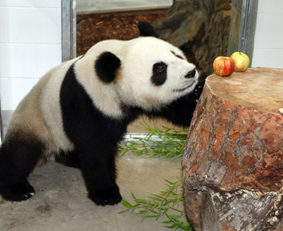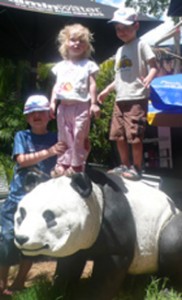Pampered pandas a star act
It is the cruellest of days to take the grand-children to see Adelaide Zoo’s famous new residents – the exotic Giant Pandas. The children have flown here from London for a holiday, the highlight being to meet Wang Wang and Funi and

Funi - photo by Bryan Charlton
they have been hyped up for months about it. Only the bravest grandma would say “it’s too hot today’’ because tomorrow they leave.
So, here we are on Monday morning walking past the oldest Zoo residents, the magnificent flamingos, as the temperature climbs to 34 degrees – and it’s only 10.40am. I have not visited the zoo since my own children were small, so the new, sophisticated zoo entry complex is a treat. The children race ahead through the gloriously cool rain forest approach into a long lineup befitting a pop concert, but these performers are big fluffy balls of pampered fur – the only pandas in the southern hemisphere.
Our three little charges are boys aged eight and six and a two-year-old grand-daughter who fidgets in the pusher, and we are bombarded with questions about the pandas until, mercifully, we are ushered into the beautiful new $8 million enclosures, where even the mountain-like rocks are cooled.
It is a glorious Asian garden approach until a volunteer whispers to us that Funi is shy and we will find her hiding at the top of her salubrious accommodation, behind a pencil pine. “There she is,’’ calls Samuel, for all 50 people gathered here to hear. You would think he had discovered gold. But, “Lucky Girl’’, which is what Funi means is right at the top of the “mountain’’ and merely peeps shyly down at us all before turning away and nuzzling into some grasses. She is whiter than white with those big blotches of black fur to define her breed. “No, she is not a walking toy,’’ we explain to Josephine, who clings to her own fluffy “Mr Teddy’’, a slightly ragged toy wearing the ravages of world travel.
“Funi is a wild animal and she lives in the zoo.’’
We push the children to the front of the taller crowd and we note Funi is doing very little indeed. She is oblivious to the crowd and sticks to her high shelf, which simulates the mountainous terrain of South-West China, where the endangered species still exists in small numbers in the wild.
Not Wang Wang on his own recreated “mountain side’’ on the other side of the glassed enclosure, (where they spend each night apart, for the time being until they mature). Wang Wang is a star performer today, despite the piercing sun and he paces back and forth in his ambling manner. Down the well-worn path on the lawned hillside, he strolls. Deftly, he climbs over the rocks, lowers himself into the dry rubble creek bed and wanders along before clamouring back up again.
The children have squatted right next to the glass wall, under the shady verandah, which separates them from the wild animal. “Look, he’s coming our way,’’ calls Angus, beckoning, just in case we had taken our eyes off the striking, wonderful animal. And soon they are wide-eyed and silent as he returns brushing the very glass with his whiteish coat. Josephine puts out her hand to touch the glass, he is so close to her. The rock on which they sit extends beneath the glass wall, but Wang Wang’s side is cooled, although he does not sit down, literally, alongside them. His fur coat is creamier with shades of coffee colour on his hind quarters. He ambles on his early morning walk, oblivious to the fierce sun beating down. But it is his tiny black eyes which sparkle out of their black fur patches which mesmerises us as hubby snaps a hundred photographs of the rare animal.
Wang Wang climbs up to the top of a small water fall, carefully moving down the steep embankment into the pool, where he stands still and drinks. It is a rare, wonderful experience, particularly because Wang Wang usually loves to snooze. Aha! He stops. He finds a small piece of bamboo, no bigger than a bush biscuit. He squats down and munches on it.
We have learnt from their lineage on display in the central shaded court, that both young pandas are descended from wild grandparents, but were born in captivity in the Wolong Giant Panda Research Centre, China in August 05 (Wang Wang) and August 06 (Funi).
We tear ourselves away from the spectacle and tell the children our Giant

The Grandchildren play Pandas
Pandas are young teenagers and have been carefully chosen because they are healthy, friendly and easy to handle. They are considered a fantastic genetic pairing for the global Giant Panda breeding program. “Everyone in the world hopes they will like each other and have baby cubs,’’ I tell them.
By high noon, it is century heat, but we continue on because each attraction fascinates the children and we are enthralled by their joy. They don’t feel the heat as they scoot from the reptile house, past the giraffes, where we cannot help but compare the sparcity of the giraffes’ zoo lifestyle compared with the giant pandas, and to the nocturnal house. Outside, we stop under a shady tree for our picnic lunch and munch on breads, pates and fruits. Onward we march following the distinctive hooting of the Orang-Utangs, past the children’s animal favourites, the lions, the tigers and the tepirs from Malaysia. They are all but comatose because of the heat – spread-eagled out under the pockets of shade in their enclosures. We hear the Orang-Utangs distinctive hooting, but they are not to be seen, today – it is too hot.
It is 2pm and the sweat pours down out faces as we rush the children to the animal nursery where only the fawn remains on all fours. We stop for ice cream and drinks where the children clambour on a plastic panda before we proceed to the panda shop where, like all good grandparents, we buy them revered souvenirs of their visit to Adelaide’s zoo to show off to their English buddies back home.
RSS feed for comments on this post. TrackBack URI



